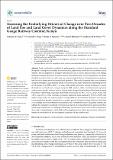Files in this item
Assessing the underlying drivers of change over two decades of land use and land cover dynamics along the Standard Gauge Railway corridor, Kenya
Item metadata
| dc.contributor.author | Sang, Catherine C. | |
| dc.contributor.author | Olago, Daniel O. | |
| dc.contributor.author | Nyumba, Tobias O. | |
| dc.contributor.author | Marchant, Robert A. | |
| dc.contributor.author | Thorn, Jessica P. R. | |
| dc.date.accessioned | 2022-05-19T16:30:06Z | |
| dc.date.available | 2022-05-19T16:30:06Z | |
| dc.date.issued | 2022-05-19 | |
| dc.identifier | 279662774 | |
| dc.identifier | ec54e34f-87cd-4a2c-94eb-28d997d39785 | |
| dc.identifier | 85131252342 | |
| dc.identifier | 000802384500001 | |
| dc.identifier.citation | Sang , C C , Olago , D O , Nyumba , T O , Marchant , R A & Thorn , J P R 2022 , ' Assessing the underlying drivers of change over two decades of land use and land cover dynamics along the Standard Gauge Railway corridor, Kenya ' , Sustainability , vol. 14 , no. 10 , 6158 . https://doi.org/10.3390/su14106158 | en |
| dc.identifier.issn | 2071-1050 | |
| dc.identifier.other | ORCID: /0000-0003-2108-2554/work/117568930 | |
| dc.identifier.uri | https://hdl.handle.net/10023/25416 | |
| dc.description | Funding: We acknowledge funding from the UK Research and Innovation’s Global Challenges Research Fund (UKRI GCRF) through the Development Corridors Partnership project (project number: ES/P011500/1). | en |
| dc.description.abstract | Land cover has been modified by anthropogenic activities for thousands of years, although the speed of change has increased in recent decades, particularly driven by socio-economic development. The development of transport infrastructure can accelerate land use land cover change, resulting in impacts on natural resources such as water, biodiversity, and food production. To understand the interaction between land cover and social–ecological drivers, changing land cover patterns and drivers of change must be identified and quantified. This study documents land cover dynamics along the Standard Gauge Railway (SGR) corridor in Kenya and evaluates the underlying drivers of this change from 2000 to 2019. The study utilised GIS and remote sensing techniques to assess the land use and land cover changes along the SGR corridor, while correlational and regression analyses were used to evaluate various drivers of the changes. Results showed that built-up areas, bare lands, water bodies, croplands and forests increased by 144.39%, 74.73%, 74.42%, 9.32% and 4.85%, respectively, while wetlands, grasslands and shrub lands reduced by 98.54%, 67.00% and 33.86%, respectively. The underlying drivers responsible for these land use and land cover dynamics are population growth, urbanisation, economic growth and agro-ecological factors. Such land cover changes affect environmental sustainability, and we stress the need to adequately identify and address the cumulative social and environmental impacts of mega-infrastructure projects and their interacting investments. The findings of this study provide an evidence base for the evaluation of the social–ecological impacts of the SGR and the implementation of best practices that will lead to enhanced sustainability in the development corridors in Kenya and beyond. | |
| dc.format.extent | 21 | |
| dc.format.extent | 3332979 | |
| dc.language.iso | eng | |
| dc.relation.ispartof | Sustainability | en |
| dc.subject | Development corridors | en |
| dc.subject | Sustainability | en |
| dc.subject | Human activities | en |
| dc.subject | Landscape dynamics | en |
| dc.subject | Infrastructure | en |
| dc.subject | GF Human ecology. Anthropogeography | en |
| dc.subject | DAS | en |
| dc.subject | SDG 2 - Zero Hunger | en |
| dc.subject | SDG 8 - Decent Work and Economic Growth | en |
| dc.subject | SDG 15 - Life on Land | en |
| dc.subject | MCC | en |
| dc.subject.lcc | GF | en |
| dc.title | Assessing the underlying drivers of change over two decades of land use and land cover dynamics along the Standard Gauge Railway corridor, Kenya | en |
| dc.type | Journal article | en |
| dc.contributor.institution | University of St Andrews. School of Geography & Sustainable Development | en |
| dc.identifier.doi | https://doi.org/10.3390/su14106158 | |
| dc.description.status | Peer reviewed | en |
| dc.identifier.url | https://www.mdpi.com/2071-1050/14/10/6158/htm | en |
This item appears in the following Collection(s)
Items in the St Andrews Research Repository are protected by copyright, with all rights reserved, unless otherwise indicated.

